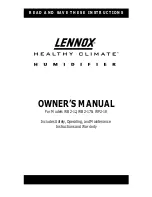
4
E
N
G
L
I
S
H
1.4 Electrical connections
A. Dryer is designed to operate on the voltage, phase,
and frequency listed on the serial number tag.
B. Dryer is supplied with a cord and plug. Install in a
receptacle of proper voltage.
NOTE:
Refrigeration condensing unit is designed to run continu-
ously and should NOT be wired to cycle on/off with the air
compressor.
NOTE:
Models 150 (115V only)—install plug in receptacle rated
for 20 amps.
1.3 Piping connections
A. Air Inlet—Connect compressed air line from air
source to air inlet.
WARNING:
Refer to Serial Number Tag for maximum
working pressure. Do not exceed dryer’s Maximum
Working Pressure.
NOTE:
Install dryer in air system at highest pressure possible
(e.g. before pressure reducing valves).
NOTE:
Install dryer at coolest compressed air temperature
possible. Maximum inlet compressed air temperature:
120
°
F (49
°
C). If inlet air exceeds this temperature, precool
the air with an aftercooler.
B. Air Outlet—Connect air outlet to downstream
air lines.
C. By-pass piping—
If servicing the dryer without interrupting the
air supply is desired, piping should include
inlet and outlet valves and an air by-pass valve.
D. Water cooled models—cooling water inlet and
outlet
1. Connect cooling water supply to cooling water
inlet.
2. Connect cooling water return line to cooling
water outlet connection.
NOTE:
Strainer and water regulating valve are supplied on water
cooled models.
Air Inlet
Air Outlet
1.5 Moisture separator
A. Separator has an internal drain which automatically
discharges collected condensate. It may be desirable
to pipe the condensate from the Automatic Drain
outlet to a suitable drain.
NOTE:
Discharge is at system pressure. Drain line should be
anchored.
NOTE:
Condensate may contain oil. Comply with applicable laws
concerning proper disposal.
B. Separator has a knurled fitting with flexible drain
tubing attached. Be sure knurled fitting is tightened
by turning it counter-clockwise before operating
dryer.
TO CLOSE
TURN COUNTERCLOCKWISE





































